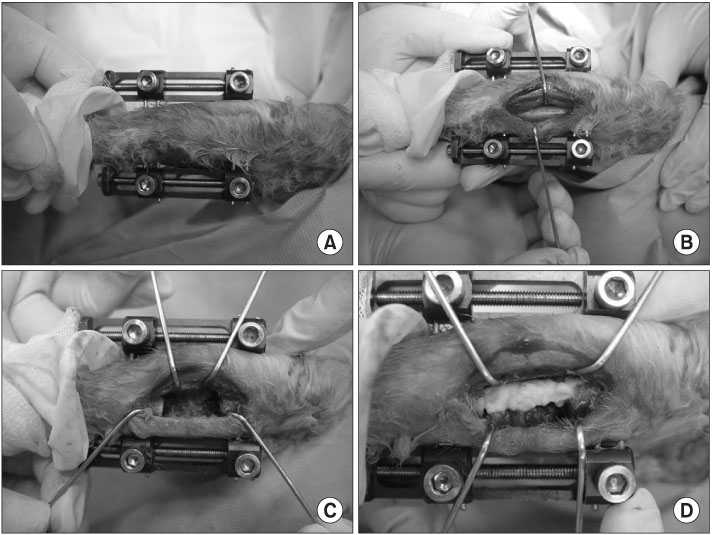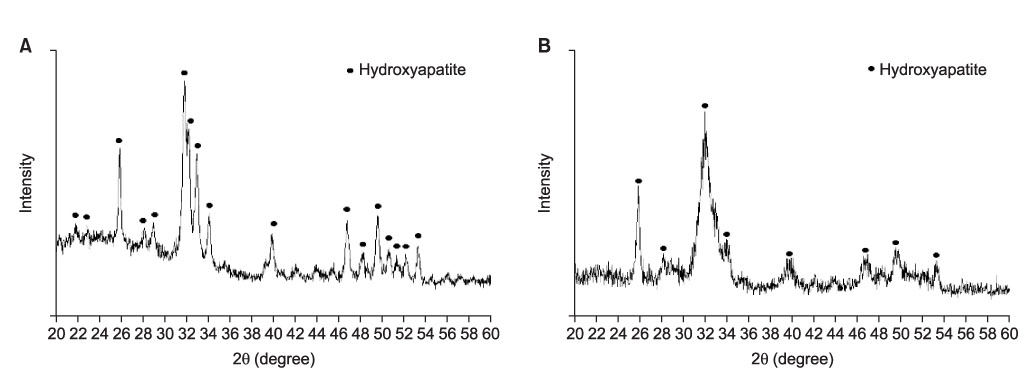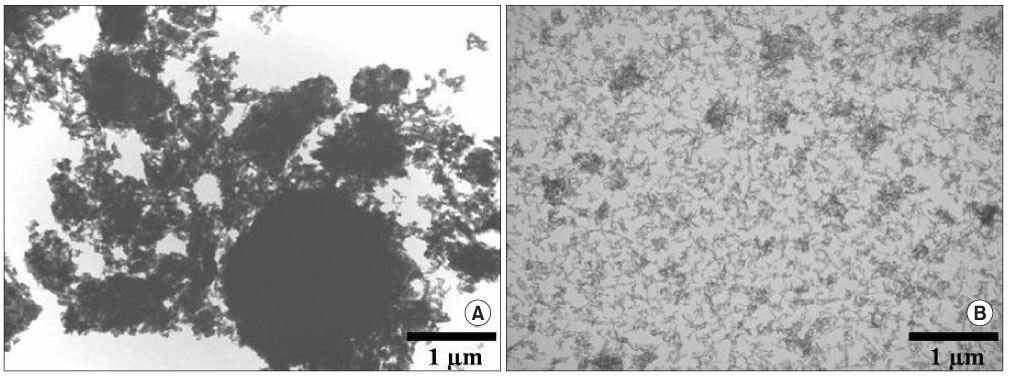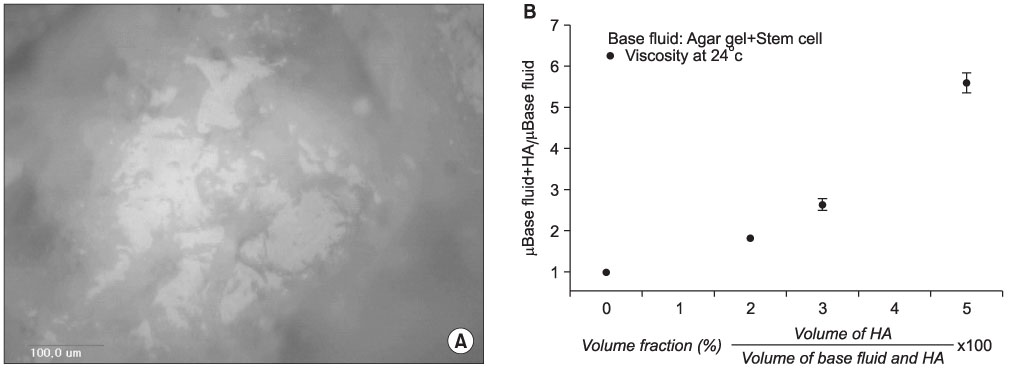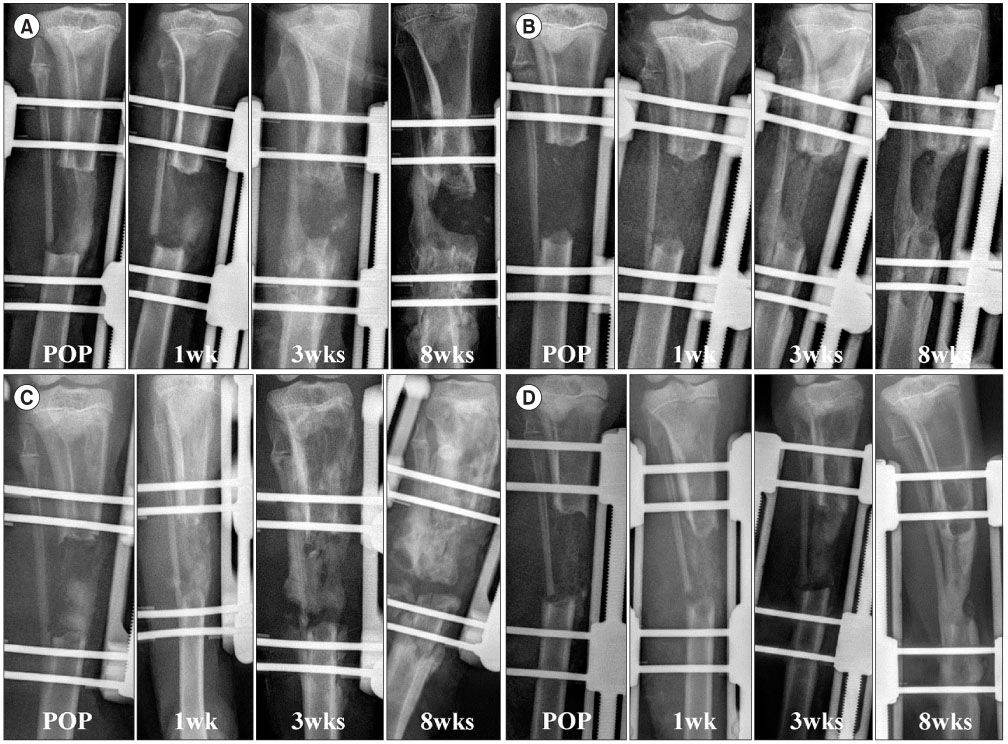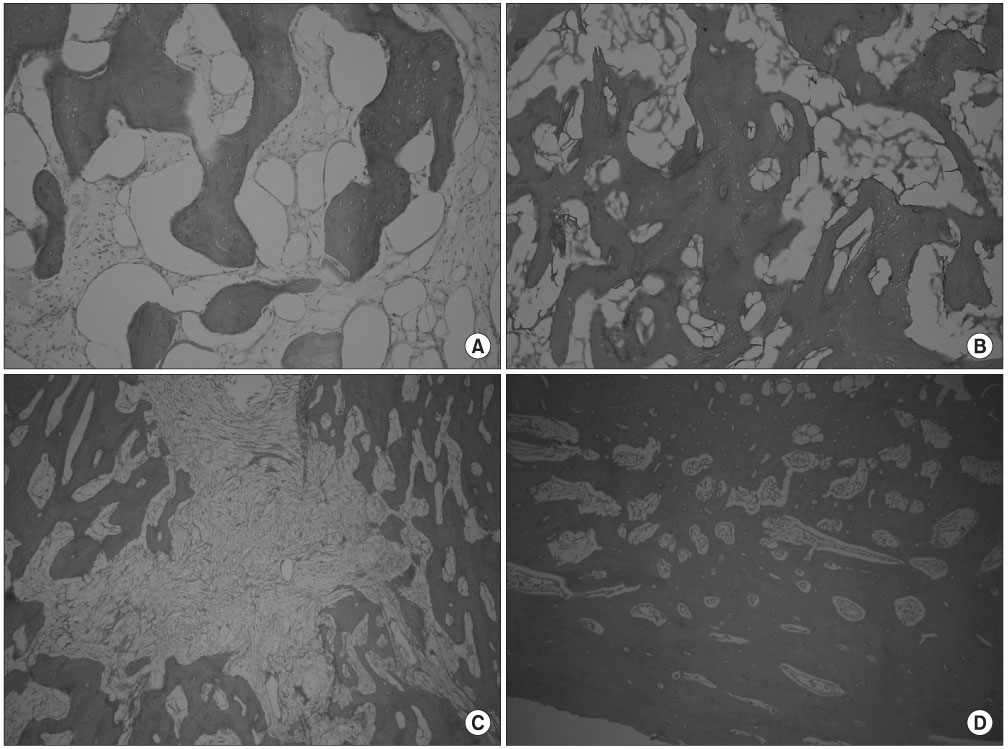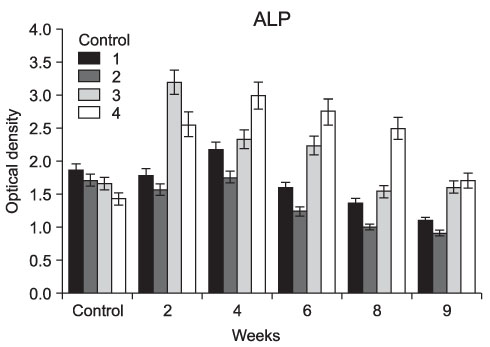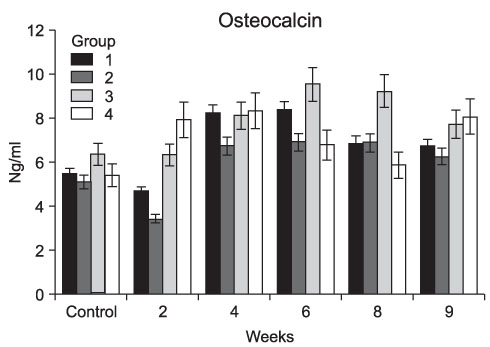J Korean Orthop Assoc.
2011 Feb;46(1):18-27. 10.4055/jkoa.2011.46.1.18.
New Bone Formation Following Transplantation of Stem Cells and Nanoscale Hydroxyapatite Scaffold Materials into Rabbit Long Bone Defects
- Affiliations
-
- 1Department of Orthopaedic Surgery, Pusan National University Hospital, Busan, Korea. kimht@pusan.ac.kr
- 2Department of Medicine, Graduate School, Pusan National University, Busan, Korea.
- 3Medical Research Institute, Pusan National University Hospital, Busan, Korea.
- 4Department of Pathology, Medical College, Kosin University, Busan, Korea.
- 5Aerospace and Mechanical Engineering, Korea Aerospace University, Goyang, Korea.
- 6Department of Advanced Materials Engineering, Chosun University, Gwangju, Korea.
- KMID: 2106567
- DOI: http://doi.org/10.4055/jkoa.2011.46.1.18
Abstract
- PURPOSE
We observed new bone formation following the transplantation of allogenic periosteum-derived stem cells and different sizes of hydroxyapatite (HA) scaffold materials into rabbit long-bone defects.
MATERIALS AND METHODS
Thirty-two white rabbits were grouped according to the material transplanted into their tibial bone defects: group 1 (microscale HA only); group 2 (nanoscale HA only); group 3 (microscale HA plus stem cells); and group 4 (nanoscale HA plus stem cells). Viscosity was controlled by the relative amounts of HA and agar. After surgery, radiologic, microscopic, and biochemical observations were performed weekly for 8 weeks.
RESULTS
Nanoscale HA (groups 2 and 4) provided better bone formation than microscale HA (groups 1 and 3). The rabbits that had been transplanted with nanoscale HA plus stem cells (group 4) had more homogeneous bone formation during the natural repair process than the other groups.
CONCLUSION
Further study is required using nanoscale HA plus organic substance and stem cells, which are more similar to human bone structure, for better bone formation.
Keyword
Figure
Reference
-
1. Moore WR, Graves SE, Bain GI. Synthetic bone graft substitutes. ANZ J Surg. 2001. 71:354–361.
Article2. Nkenke E, Schultze-Mosgau S, Radespiel-Tröger M, Kloss F, Neukam FW. Morbidity of harvesting of chin grafts: a prospective study. Clin Oral Implants Res. 2001. 12:495–502.
Article3. Webster TJ, Ejiofor JU. Increased osteoblast adhesion on nanophase metals: Ti, Ti6Al4V, and CoCrMo. Biomaterials. 2004. 25:4731–4739.
Article4. Du C, Cui FZ, Zhu XD, de Groot K. Three-dimensional nano-HAp/collagen matrix loading with osteogenic cells in organ culture. J Biomed Mater Res. 1999. 44:407–415.
Article5. Webster TJ, Ergun C, Doremus RH, Siegel RW, Bizios R. Enhanced functions of osteoblasts on nanophase ceramics. Biomaterials. 2000. 21:1803–1810.
Article6. Hamanishi C, Yoshii T, Totani Y, Tanaka S. Bone mineral density of lengthened rabbit tibia is enhanced by transplantation of fresh autologous bone marrow cells. An experimental study using dual X-ray absorptiometry. Clin Orthop Relat Res. 1994. (303):250–255.7. Heraeus Kulzer. Ostim-Vollsynthetischer Knochenersatz "ready to use". Das Deutsche Zahnarzteblatt. 2003. 5:67.8. Jang SP, Lee JH, Hwang KS, Choi SUS. Particle concentration and tube size dependence of viscosities of Al2O3-water nanofluids flowing through micro- and minitubes. Appl Phys Lett. 2007. 91:243112.9. LeGeros RZ. Apatites in biological systems. Prog Cryst Growth Charact. 1981. 4:1–45.10. LeGeros RZ. Calcium phosphate materials in restorative dentistry: a review. Adv Dent Res. 1988. 2:164–180.
Article11. Kim HW, Knowles JC, Kim HE. Hydroxyapatite and gelatin composite foams processed via novel freeze-drying and crosslinking for use as temporary hard tissue scaffolds. J Biomed Mater Res A. 2005. 72:136–145.
Article12. Yaylaoğlu MB, Korkusuz P, Ors U, Korkusuz F, Hasirci V. Development of a calcium phosphate-gelatin composite as a bone substitute and its use in drug release. Biomaterials. 1999. 20:711–719.13. Schwartz Fo HO, Novaes AB Jr, de Castro LM, Rosa AL, de Oliveira PT. In vitro osteogenesis on a microstructured titanium surface with additional submicron-scale topography. Clin Oral Implants Res. 2007. 18:333–344.
Article14. Anselme K. Osteoblast adhesion on biomaterials. Biomaterials. 2000. 21:667–681.
Article15. Colon G, Ward BC, Webster TJ. Increased osteoblast and decreased Staphylococcus epidermidis functions on nanophase ZnO and TiO2. J Biomed Mater Res A. 2006. 78:595–604.16. Thorwarth M, Schultze-Mosgau S, Kessler P, Wiltfang J, Schlegel KA. Bone regeneration in osseous defects using a resorbable nanoparticular hydroxyapatite. J Oral Maxillofac Surg. 2005. 63:1626–1633.
Article17. Yaakobi T, Maltz L, Oron U. Promotion of bone repair in the cortical bone of the tibia in rats by low energy laser (He-Ne) irradiation. Calcif Tissue Int. 1996. 59:297–300.
Article18. Yoo JU, Johnstone B. The role of osteochondral progenitor cells in fracture repair. Clin Orthop Relat Res. 1998. 355 Suppl. S73–S81.
Article19. Obrant KJ, Merle B, Bejui J, Delmas PD. Serum bone-gla protein after fracture. Clin Orthop Relat Res. 1990. (258):300–303.
Article20. Ohishi T, Takahashi M, Kushida K, et al. Changes of biochemical markers during fracture healing. Arch Orthop Trauma Surg. 1998. 118:126–130.
Article21. Kim HW, Kim HE, Salih V. Stimulation of osteoblast responses to biomimetic nanocomposites of gelatin-hydroxyapatite for tissue engineering scaffolds. Biomaterials. 2005. 26:5221–5230.
Article22. Elias KL, Price RL, Webster TJ. Enhanced functions of osteoblasts on nanometer diameter carbon fibers. Biomaterials. 2002. 23:3279–3287.
Article23. Yamaguchi I, Tokuchi K, Fukuzaki H, et al. Preparation and microstructure analysis of chitosan/hydroxyapatite nanocomposites. J Biomed Mater Res. 2001. 55:20–27.
Article24. Hench LL. Bioceramics: from concept to clinic. J Am Ceram Soc. 1991. 74:1487–1510.
Article25. Mann S, Ozin GA. Synthesis of inorganic materials with complex form. Nature. 1996. 365:499–505.
Article26. Zerwekh JE, Kourosh S, Scheinberg R, et al. Fibrillar collagen-biphasic calcium phosphate composite as a bone graft substitute for spinal fusion. J Orthop Res. 1992. 10:562–572.
Article
- Full Text Links
- Actions
-
Cited
- CITED
-
- Close
- Share
- Similar articles
-
- Periosteum-Derived Mesenchymal Stem Cells and Scaffolds Transplanted into Long-Bone Defects of Rabbit
- Comparison of Bone Formation between Allogenic Periosteum-Derived Mesenchymal Stem Cells and Cultured Osteoblasts Transplanted into Long-Bone Defects of Rabbits
- Mesenchymal Stem Cells of Different Origin-Seeded Bioceramic Construct in Regeneration of Bone Defect in Rabbit
- A Comparative Study on Regeneration of Bone Defects after the Grafts of Demineralized Bone Matrix and Hydroxyapatite
- Three-dimensional Culture of Bone Marrow Derived Mesenchymal Stem Cellson Several Scaffolds and Osteogenic Potential of Cell-Scaffold Compositein Vivo

